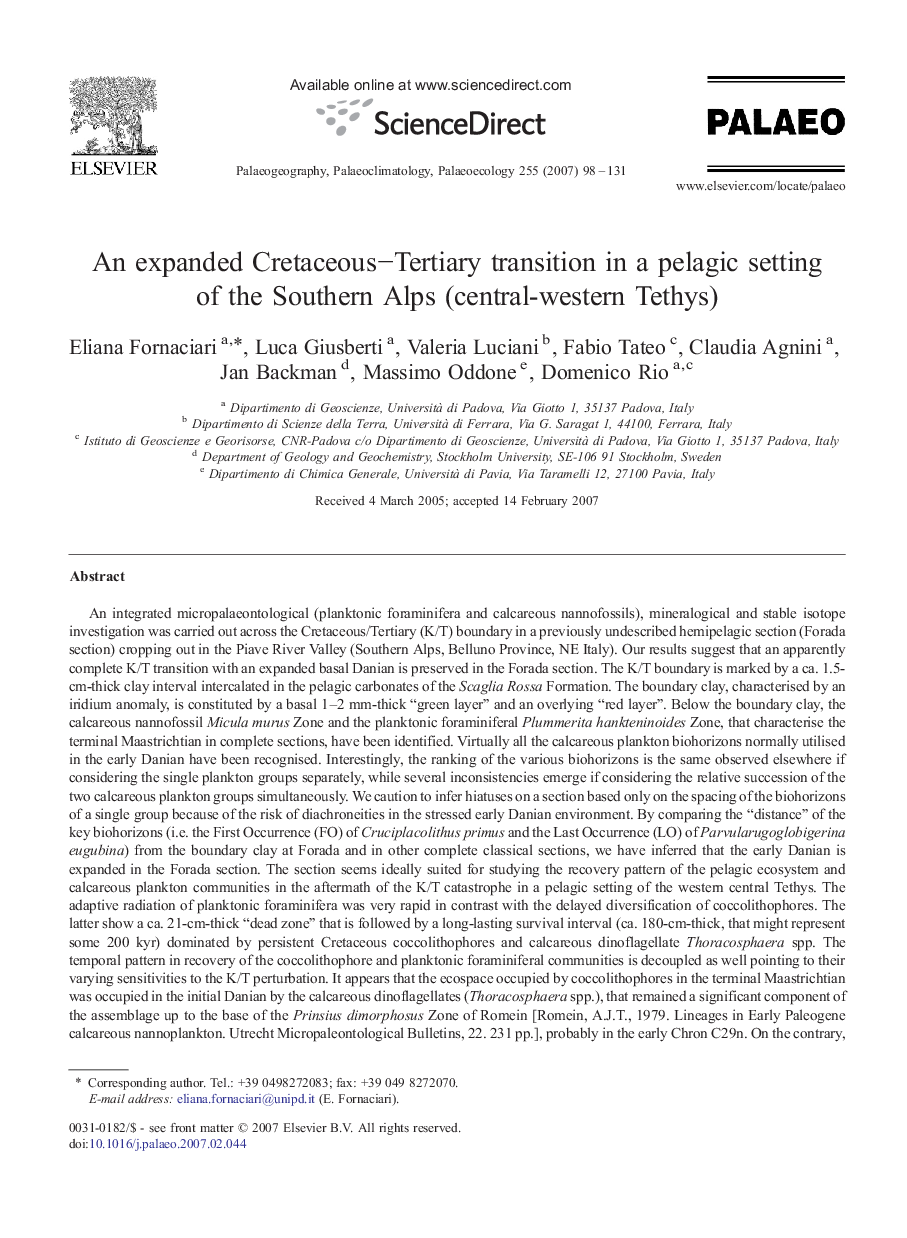| کد مقاله | کد نشریه | سال انتشار | مقاله انگلیسی | نسخه تمام متن |
|---|---|---|---|---|
| 4468682 | 1622341 | 2007 | 34 صفحه PDF | دانلود رایگان |

An integrated micropalaeontological (planktonic foraminifera and calcareous nannofossils), mineralogical and stable isotope investigation was carried out across the Cretaceous/Tertiary (K/T) boundary in a previously undescribed hemipelagic section (Forada section) cropping out in the Piave River Valley (Southern Alps, Belluno Province, NE Italy). Our results suggest that an apparently complete K/T transition with an expanded basal Danian is preserved in the Forada section. The K/T boundary is marked by a ca. 1.5-cm-thick clay interval intercalated in the pelagic carbonates of the Scaglia Rossa Formation. The boundary clay, characterised by an iridium anomaly, is constituted by a basal 1–2 mm-thick “green layer” and an overlying “red layer”. Below the boundary clay, the calcareous nannofossil Micula murus Zone and the planktonic foraminiferal Plummerita hankteninoides Zone, that characterise the terminal Maastrichtian in complete sections, have been identified. Virtually all the calcareous plankton biohorizons normally utilised in the early Danian have been recognised. Interestingly, the ranking of the various biohorizons is the same observed elsewhere if considering the single plankton groups separately, while several inconsistencies emerge if considering the relative succession of the two calcareous plankton groups simultaneously. We caution to infer hiatuses on a section based only on the spacing of the biohorizons of a single group because of the risk of diachroneities in the stressed early Danian environment. By comparing the “distance” of the key biohorizons (i.e. the First Occurrence (FO) of Cruciplacolithus primus and the Last Occurrence (LO) of Parvularugoglobigerina eugubina) from the boundary clay at Forada and in other complete classical sections, we have inferred that the early Danian is expanded in the Forada section. The section seems ideally suited for studying the recovery pattern of the pelagic ecosystem and calcareous plankton communities in the aftermath of the K/T catastrophe in a pelagic setting of the western central Tethys. The adaptive radiation of planktonic foraminifera was very rapid in contrast with the delayed diversification of coccolithophores. The latter show a ca. 21-cm-thick “dead zone” that is followed by a long-lasting survival interval (ca. 180-cm-thick, that might represent some 200 kyr) dominated by persistent Cretaceous coccolithophores and calcareous dinoflagellate Thoracosphaera spp. The temporal pattern in recovery of the coccolithophore and planktonic foraminiferal communities is decoupled as well pointing to their varying sensitivities to the K/T perturbation. It appears that the ecospace occupied by coccolithophores in the terminal Maastrichtian was occupied in the initial Danian by the calcareous dinoflagellates (Thoracosphaera spp.), that remained a significant component of the assemblage up to the base of the Prinsius dimorphosus Zone of Romein [Romein, A.J.T., 1979. Lineages in Early Paleogene calcareous nannoplankton. Utrecht Micropaleontological Bulletins, 22. 231 pp.], probably in the early Chron C29n. On the contrary, planktonic foraminifera seem to reach stable conditions earlier, in the late Cruciplacolithus primus Zone. The early Danian interval considered is also characterised by low Sr/Ca ratio of the biogenic carbonates that would suggest dramatically low coccolithophore productivity conditions, in agreement with previous flux studies. We speculate that the altered ecological structure of phytoplankton community and the low productivity of coccolithophores severely affected the efficiency of the transfer of organic carbon from the photic zone to the deep ocean, thus supporting the early Danian “living ocean” model of D'Hondt et al. [D'Hondt, S., Donaghay, P., Zachos, J.C., Luttenberg, D., Lindinger, M., 1998. Organic carbon fluxes and ecological recovery from the Cretaceous–Tertiary mass extinction. Science 282, 276–279].
Journal: Palaeogeography, Palaeoclimatology, Palaeoecology - Volume 255, Issues 1–2, 2 November 2007, Pages 98–131